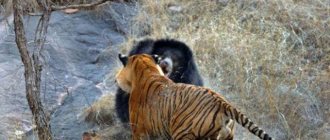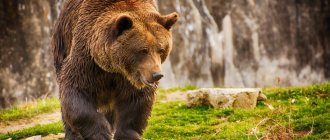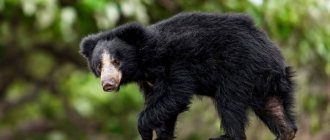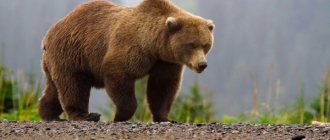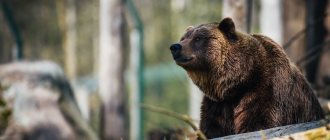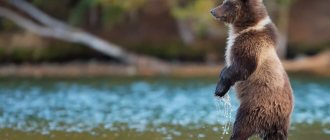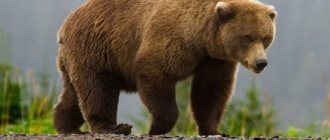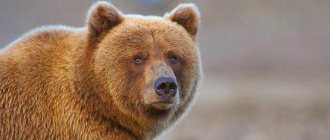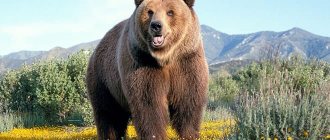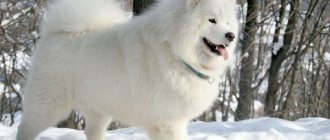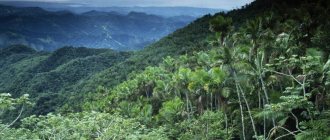Lifestyle and habitat
The forest dweller prefers areas with windbreaks, dense growth of grasses and shrubs in burnt areas. Mountain regions, tundra, and coastlines are also developed by the predator. Once upon a time, the widespread distribution of the brown bear was recorded from England to Japan.
But changes in inhabited territories and the extermination of the beast led to a significant compression of the range. The forest zones of western Canada, Alaska, and the Russian Far East are its main habitats.
Each bear has a separate territory, ranging in size from 70 to 140 km², marked by smells and noticeable scratches on the trees. The male's area is 7 times larger than that of the female. The territory is defended from strangers. The separated young animals, in search of a partner, can actively wander beyond the boundaries of the site.
The predator is active during daylight hours, often in the early morning and evening. In search of food, the sedentary animal sometimes makes seasonal movements, following to areas where berries and nuts ripen.
Despite the large size of the animal and its clumsy appearance, the predator runs quickly. The average speed of a brown bear is 50-60 km/h. The physical activity and plasticity of the animal is manifested in the ability to climb trees, swim across rivers, and cover significant distances.
The bear has the ability to approach prey silently and with light movements. With a strong blow of his paw he can break the back of a deer or wild boar.
The sense of smell allows the animal to smell the decomposition of meat 3 km away. Hearing is acute. The bear often stands up on its hind legs and listens to its surroundings, catching smells. A difficult obstacle for a bear is deep snow cover.
The life of a predator has a seasonal cycle. In the summer, well-fed bears rest on the ground, among herbs, bask in the sun, and take care of their offspring. In the fall, they are busy looking for a winter shelter, arranging it, and accumulating subcutaneous fat.
In winter, a deep sleep occurs, which lasts from one month to six, depending on many factors. It is interesting that the physiological parameters of the animal (pulse, temperature, etc.) practically do not change, unlike other mammals.
Spring awakens weakened animals. Weight loss over the winter can be quite significant - up to 80 kg. The accumulation of strength for a new life cycle begins.
Location
The natural habitat of the clubfoot is quite variable: from the Arctic to Canada. Some types of bears live in Europe, while others live in Australia. There are also differences; each representative chooses unique housing: dens, caves, hollows.
Note!
- Euthanasia of animals.
- Spitz. Features of the breed.
Car hammock for dogs. What it is?
The only thing that can be said for sure is that all species lead a solitary lifestyle, and only sometimes families with a mother bear and cubs can be found. Their natural habitat is mixed forests and swampy areas.
Wintering
Bears stay in their den from October to April. In general, hibernation lasts six months; old males are the first to emerge.
The last ones are mothers and offspring.
The den itself is chosen especially carefully, somewhere in secluded places on the borders of swamps, in the thickets of the forest or in caves.
The omnivore arranges it in his own way: he lays out moss and insulates it with branches and leaves.
Before plunging into suspended animation, the bear can confuse its tracks by looping or walking backwards. All its preparation consists of the accumulation of nutrients.
All winter long the dormouse sleeps curled up in a ball. Breathing and heart rate slow down in this state.
An interesting feature during this period of time is that the animal does not defecate. Waste products are recycled, turning into harmless proteins that are so necessary for its existence.
Connecting rods
Many people wonder, who are they? The fact is that some of the representatives of the species, for one reason or another, do not have time to get that same portion of fat reserves.
Because of this, they are forced to wander through the forest in the cold, trying to find meager food supplies. This animal is very dangerous, so you should stay away from it.
Food for the clubfoot
Basically, the diet of this animal consists of roots and nuts. Since bears are omnivores, fish, frogs and other small animals are considered a delicacy for them. Although, in addition to the above, they are not averse to eating the meat of deer or roe deer, going out hunting at dusk or in the morning.
During spawning, they actively catch fish: an excellent reaction, coupled with impressive paws, produces results.
Note!
- Removal and cremation of animals
Cynologists - who are they?
Car soundproofing. What is she like?
Also, which is typical for the brown representative, some of them are not at all averse to tasting cereal plants. In general, 75 percent of the diet is plant foods.
